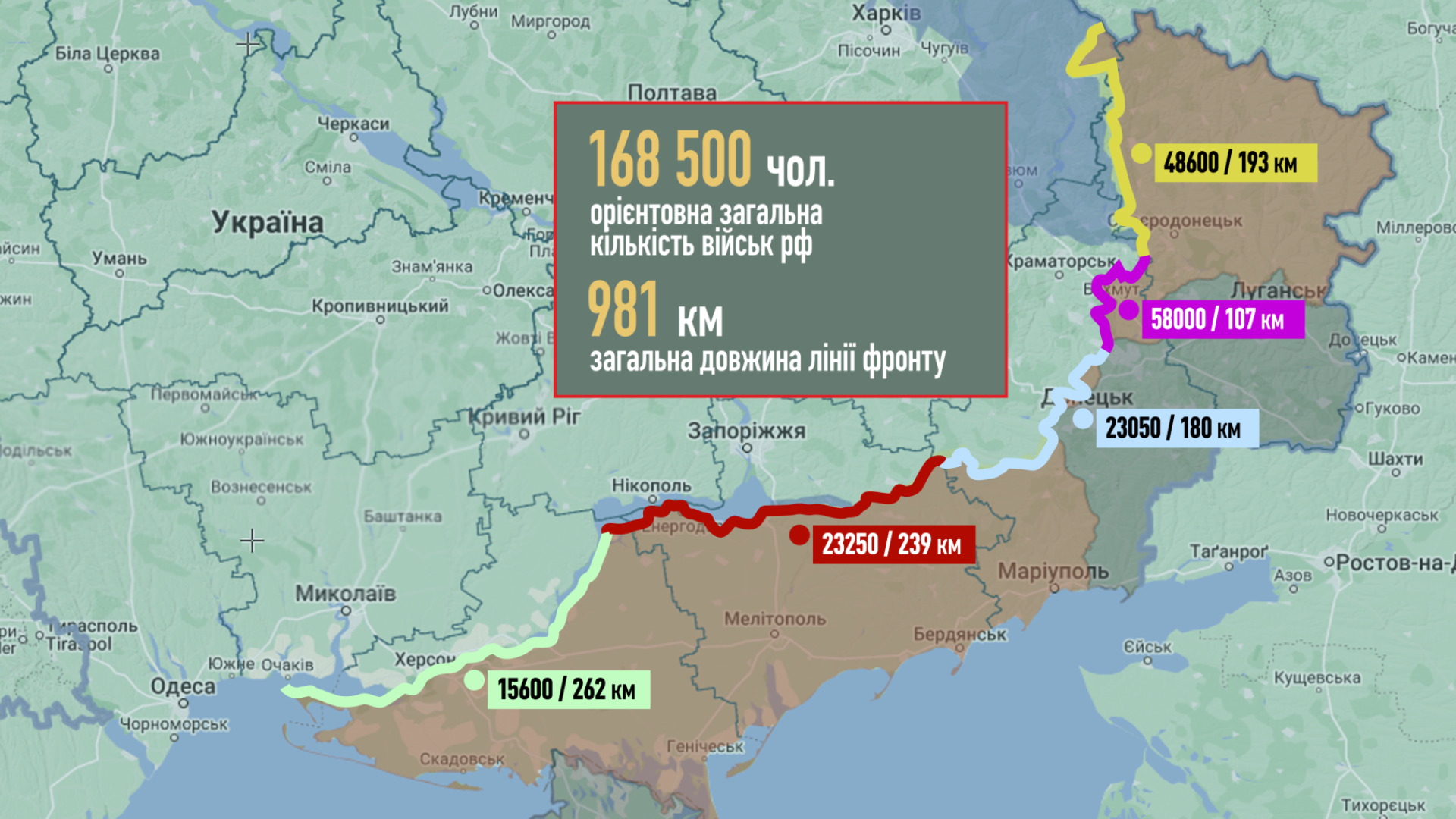
Who has battlefield initiative, what tactics to expect from Russia and why Egypt decides not to provide weapons for the Russian Federation -Serhiy Zgurets
Based on the Pentagon's open sources, we have prepared a map of Russian troops on Ukrainian territory: the largest grouping is deployed from Bilohorivka to Vuhledar
Zelenskyy visits defenders in Avdiivka
On April 18, President of Ukraine, Volodymyr Zelenskyy, visited the frontline positions of Ukrainian defenders in Avdiivka, where he presented state awards to soldiers. This is a crucial gesture as it reinforces the military's understanding that they have the support of their Supreme Commander, and it is a significant event for our society.
Avdiivka is among the most volatile areas on the front line, where the enemy continues to attempt to advance. However, we now have several such areas, including Marinka and Bakhmut. Speaking of Bakhmut, on the same day, Ground Forces Commander, Oleksandr Syrskyi, stated that the enemy persists in their efforts to seize Bakhmut and is using heavy artillery and air strikes, causing extensive damage to the city. Nevertheless, our soldiers are inflicting significant losses on the enemy and maintaining their hold on this fortress. General Syrskyi reported that the enemy is conducting offensive operations in five directions. Additionally, General Budanov, the chief of Intelligence, revealed that the enemy is transitioning to defensive tactics and continues to concentrate their efforts in only two critical areas where they are trying to advance.
Current battlefield situation
According to Serhii Hrabskyi, a military expert and reserve colonel who has participated in peacekeeping missions, the enemy currently has the initiative on the battlefield. This is due to their advantage in the number of personnel and armament of military equipment. The enemy offensives are being conducted in five areas where Ukrainian troops are defending hile Ukrainian troops are deterring the enemy and carrying out preventive actions, they are not advancing anywhere at the moment. Therefore, it would be premature to say that Ukraine has seized the initiative and is dictating terms to the enemy.
The Russians are starting to move towards strategic defense on their own initiative because they have been unable to accumulate enough resources and conduct active combat operations. However, the enemy is still carrying out local offensive actions in five separate areas, which is considered an initiative in their hands. The difficult combat conditions under which Ukrainian troops are currently operating should also be acknowledged.

Hrabskyi estimated that up to 300,000 Russian personnel, including reserves, are operating on the Ukrainian fronts. There are noticeable discrepancies in the estimates of the number of Russian troops because some forces and means are stored in unmarked areas. Additionally, tens of thousands of Russian troops are spread over a distance of about 600 km. The numbers given by the GUR referred only to armed formations of the Russian Federation involved in one or another direction.
Hrabskyi noted that the Belgorod region has a powerful potential for the enemy's concentration of forces and means. There are also units undergoing training at five training centers in Belarus, estimated to be between five to seven thousand personnel, which are being used to replenish the ranks of the occupiers.
The enemy is using small assault groups quite effectively and skillfully. They have created assault units, which are a clear indication of their improvised approach to combat operations. The enemy can continue to use such tactics for a long time.
The situation on the battlefield remains tense, and both Ukraine and Russia are aware of the importance of future offensive operations. While Russia continues to conduct grueling military operations in Donbas, the southern direction remains more expedient for Ukraine. However, only the Supreme Command knows whether an offensive will be conducted in that direction. It is essential to calmly observe the development of events.
Ammunition supply from Egypt to Ukraine
The Washington Post recently reported on the supply of ammunition to Ukraine from Egypt, a country that was initially planning to sell these weapons to Russia. The Pentagon's newly merged files revealed that Egypt was negotiating with Russia in January of this year to supply 40,000 unguided rockets for the Grad system. After agreeing on a price of $1,500 per unit, the two countries were about to enter into a contract. However, in March, representatives from the US visited Cairo, and Defense Minister Lloyd Austin personally asked the Egyptian president to ensure the supply of artillery ammunition to Ukraine. After some delay, the Egyptian leadership agreed to supply 122 mm and 155 mm ammunition to Ukraine, causing the planned visit from Cairo to Moscow to be canceled. Interestingly, these ammunitions will be purchased by the US and then transferred to Ukraine. Egypt has a significant number of Soviet systems, particularly missile weapons and anti-aircraft missile systems such as S-300, Buk, and S-125. Acquiring these missiles would significantly strengthen Ukraine's air defense capabilities. The US has leverage over Egypt, as the country receives approximately $1 billion in aid from the US every year, making it dependent on Washington for many projects.
Large-scale NATO exercises
Preparations for the large-scale military exercise Anakonda-23 are beginning in Poland, with at least 13,000 military personnel from various NATO countries participating. Dariusz Materniak, the head of the Poland-Ukraine Research Center, commented that the exercise's scenario corresponds to the challenges faced by the region at the moment, including large-scale Russian aggression and threats to Poland and neighboring countries. The exercise will also dedicate a significant component to strengthening logistical capabilities, as the transfer of equipment to Ukraine is currently hindered by logistical problems and border crossings. The goal is to resolve these issues and create conditions for the transfer of equipment along NATO's borders to be carried out quickly and without obstacles. After Anakonda-23, there will be a series of exercises throughout the eastern axis of Alliance countries in response to Russian aggression. These efforts demonstrate NATO's commitment to transforming and improving cooperation between member countries to repel Russian aggression effectively.
- News














































